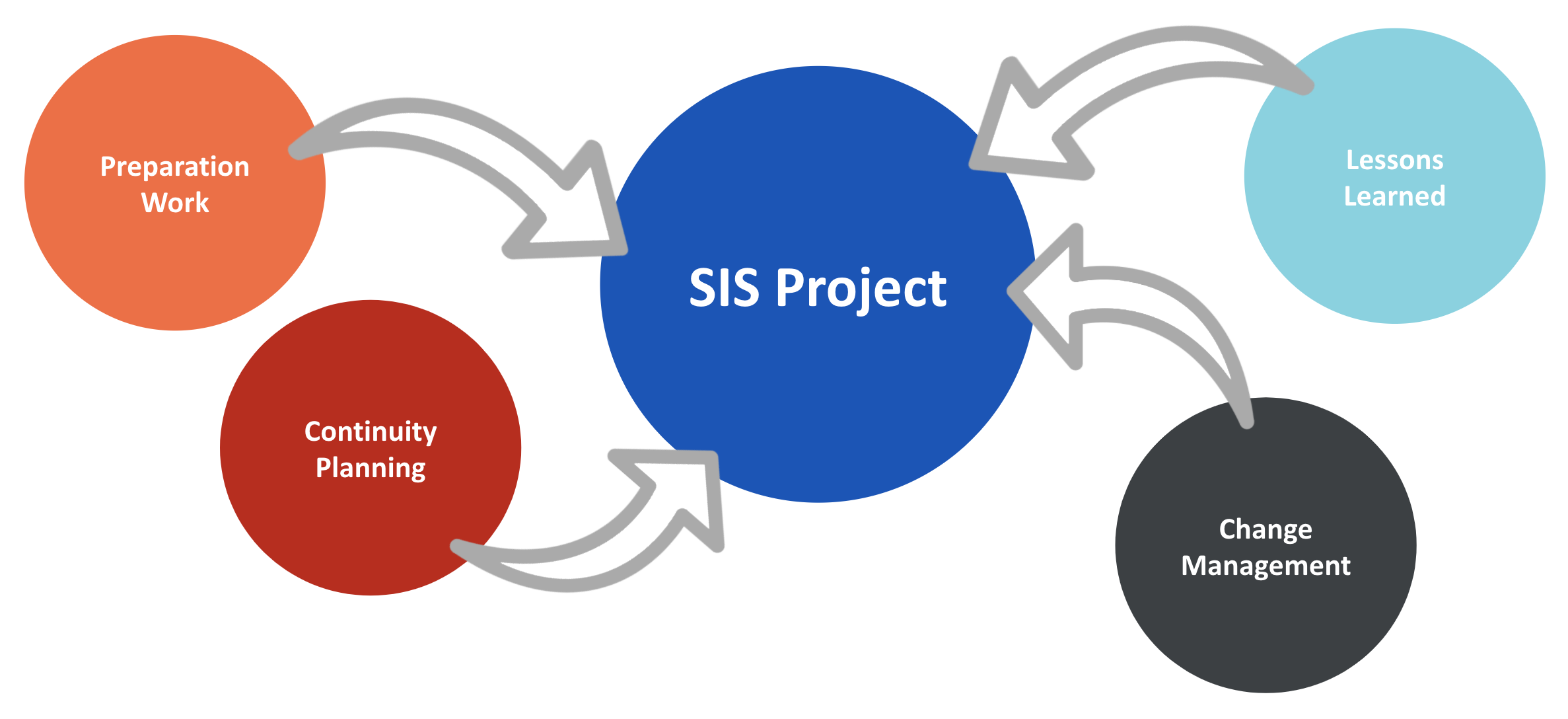Managing Project Scope
One of the key roles of any project team guided by project governance is to control the scope of the project. As a project progresses and plans become more developed, it’s normal for the project specifics to change and evolve.
It is critical, however, to monitor that natural project evolution to ensure it does not include any significant changes to the original goals and vision of the project. Any deviations from the original project scope, called “scope creep” in project management lingo, must be taken to the project sponsor for review and approval.
While the SIS project awaits the outcome of the RFP seeking a vendor partner, the core project team reviewed the scope of the project to ensure we were still aligned with our original goals. While the scope of the project has not changed, through conversations with project leaders and key stakeholders, we discovered that the way we had been talking about the project and the work supporting the project had created confusion around the scope.
So, what exactly is the scope of the SIS project?
The SIS Project Scope
One way we define the scope of the project is by the functions that will be affected by the project. The chart below defines the functions in and out of scope for the SIS project.
In ScopeWhat will be replaced or will change significantly as a result of the SIS project |
Out of ScopeWhat will not be replaced or will not change significantly as a result of the SIS project |
|
|
In the future state, the functions in the “in scope” side of the chart will be managed by one or more new systems implemented throughout the course of the project.
Another way to think about the same scope is in terms of the systems that will be either replaced as a result of the project or maintained and integrated with the new systems. The chart below details the systems expected to be replaced or maintained.
New or Replaced |
Maintained or Improved |
|
|
Of the systems that will be maintained, some may also be improved to ensure that they continue to meet the needs of their users. Those improvements, however, are outside of the scope of the project itself.
While the project scope exists to clearly define what the project will deliver, with a project as large and complex as the SIS project, a lot must happen in addition to the direct project work to ensure its defined goals and vision become reality.
What else, then, is happening to support the SIS project?
Project Planning and Support
For the SIS project, there are four key areas where advance planning or support activities are currently taking place: preparation work, continuity planning, lessons learned, and change management. While these areas do not represent direct project work, they do help lay the foundation for successful project execution.
While the project itself is awaiting the outcome of the current RFP, this supporting work is happening to prepare the University for the next steps of the project.

Preparation work (previously referred to as “pre-hab” or “pre-habilitation” work) currently in progress for the SIS project includes report remediation, process mapping, and improvements to some of the systems that will be maintained after a new SIS goes live. Ongoing project preparation also includes supporting the vision of Campus and the Division of Extended Studies (DES) existing together in the same system by bringing DES onto existing Campus tools, such as Slate, uAchieve and 25Live.
Continuity planning consists of identifying business processes and systems that rely on student information that might typically be stored in an SIS and then working with stakeholders to ensure those systems and processes can be continued post-implementation of a new SIS. To ensure the larger context is also being considered, ESR Continuity Planning is involved in these activities.
Project governance and the project team are actively seeking lessons learned and best practices from as many individuals and groups as possible, including previous and current ESR projects, stakeholders and subject matter experts (SMEs) here at the University who have been through similar projects, our sister UC campuses, and other similarly-sized universities outside of the UC system.
As project and preparation work brings change, a robust, holistic change management methodology is being employed. The change teams overseeing the change management activities are also supported by ESR’s Strategic Organizational Change Management framework and team.
In Summary…
The scope of the SIS project has been carefully defined, and it is a crucial function of project governance and the project team to ensure the project stays within its defined scope. Any changes to the project scope must be approved by the project sponsor.
To successfully execute a highly-complex project like the SIS project, additional planning and preparation must happen. This supporting work is currently underway for the SIS project and will continue into the future.
The project team is aware and appreciates that university stakeholders are eager to interact with a new SIS. It is our goal to keep you informed of our preparations for and work on the project, when it commences, as well as any changes to the scope or vision of the project. This includes clarifying and correcting our communications when necessary; we appreciate your questions and feedback, as they help us achieve this goal.
Learn more about the SIS project at esr.ucsd.edu/student.
For questions about the SIS project contact esr-student@ucsd.edu.